Abstract
1. The role of endogenous ADP in platelet aggregation in vivo remains unclear due to the lack of suitable P2T-antagonist probes. This paper describes the potency, selectivity and specificity of the novel P 2T-purinoceptor antagonist, FPL 67085 (2-propylthio-D-beta,gamma-dichloromethylene ATP) both in vitro and in the anaesthetized rat in vivo. 2. FPL 67085 (3-30 nM) produced concentration-dependent rightward displacement of the concentration-effect (E/[A]) curve for ADP-induced aggregation of human washed platelets with no effect on ADP-independent aggregation at < or = 10 microM. 3. Logistic fitting of ADP E/[A] data indicated that the antagonist effect of FPL 67085 did not consistently accord with simple competition: in some preparations depression of the asymptote was seen. Schild analysis of data combined from all preparations, regardless of the antagonist profile observed, gave an apparent pKB of 8.9 (slope parameter 0.90). 4. The potency of FPL 67085 was unaffected by the P1-purinoceptor antagonist, 8-sulphophenyltheophylline, was similar (IC50 0.6-3.8 nM) in human and rat washed platelets or whole blood and, in rat blood, did not change following 2-30 min incubation at 37 degrees C. 5. FPL 67085 was a weak (pA50 approximately 4.2) partial agonist in tissues containing P2X- or P2Y-purinoceptors, indicating some 30,000 fold selectivity for the P2T-subtype. 6. In anaesthetized rats, intravenous infusion of FPL 67085 produced rapidly-reversible, dose-related inhibition of ADP-induced platelet aggregation measured ex vivo (ID50 1.3 micrograms kg-1 min-1) with no significant effect on haemodynamics or circulating cell counts.(ABSTRACT TRUNCATED AT 250 WORDS)
Full text
PDF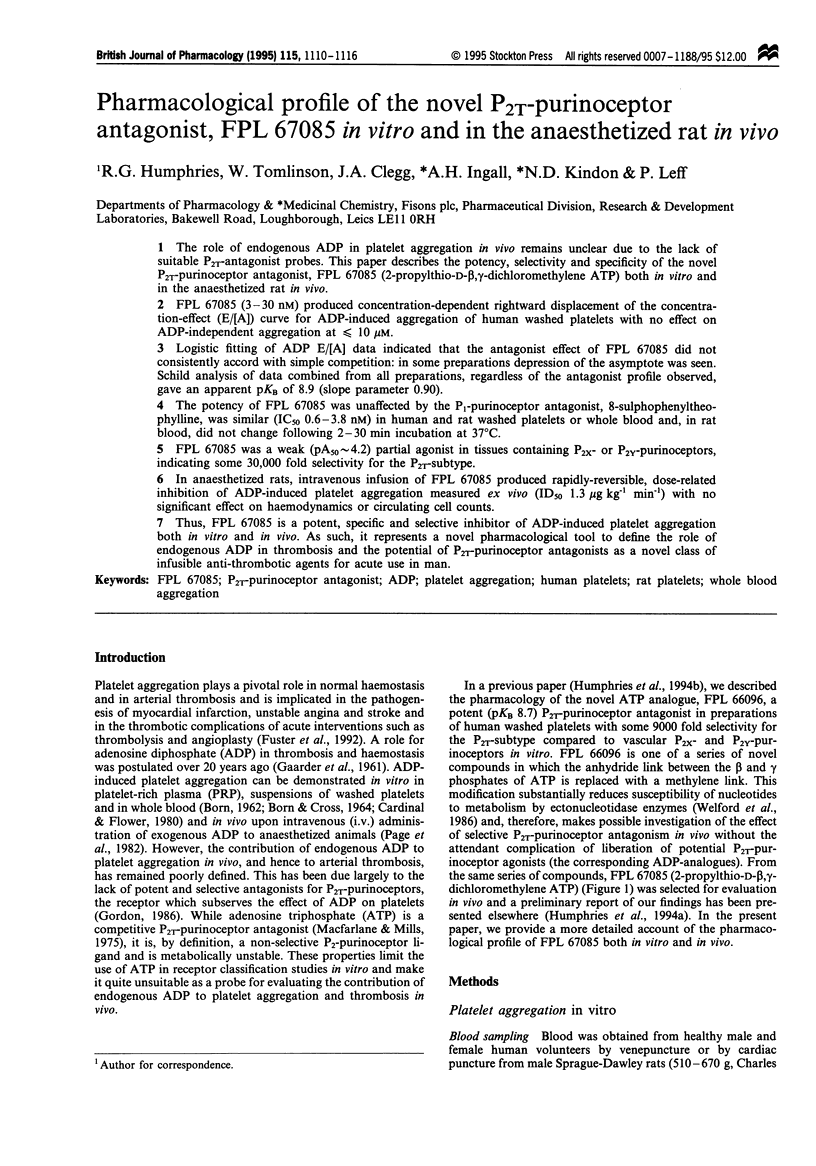
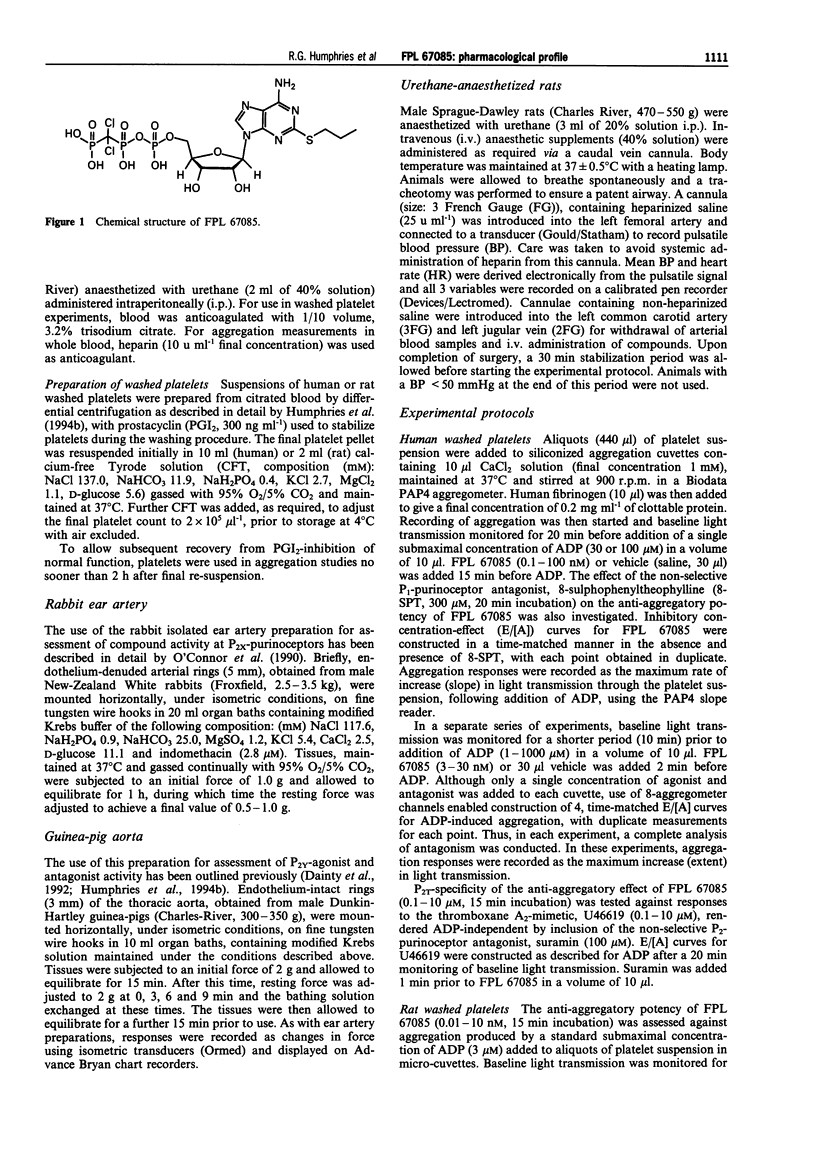
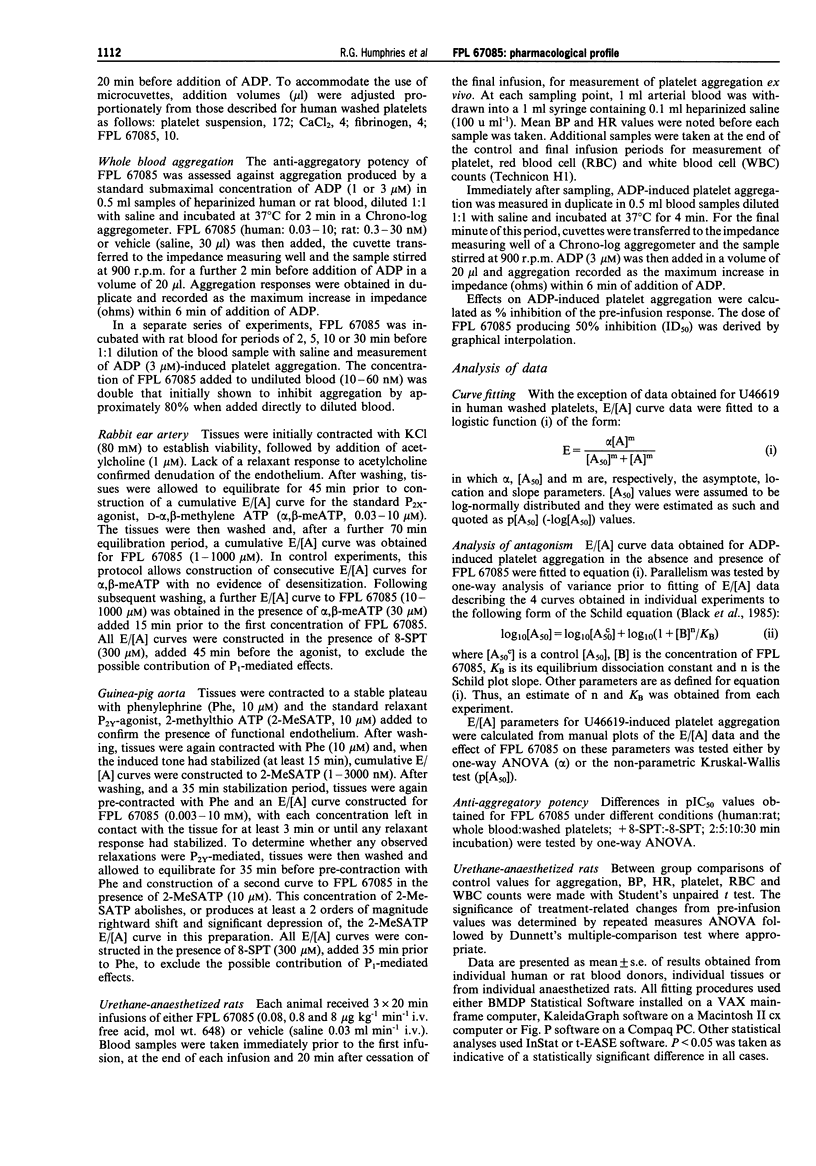
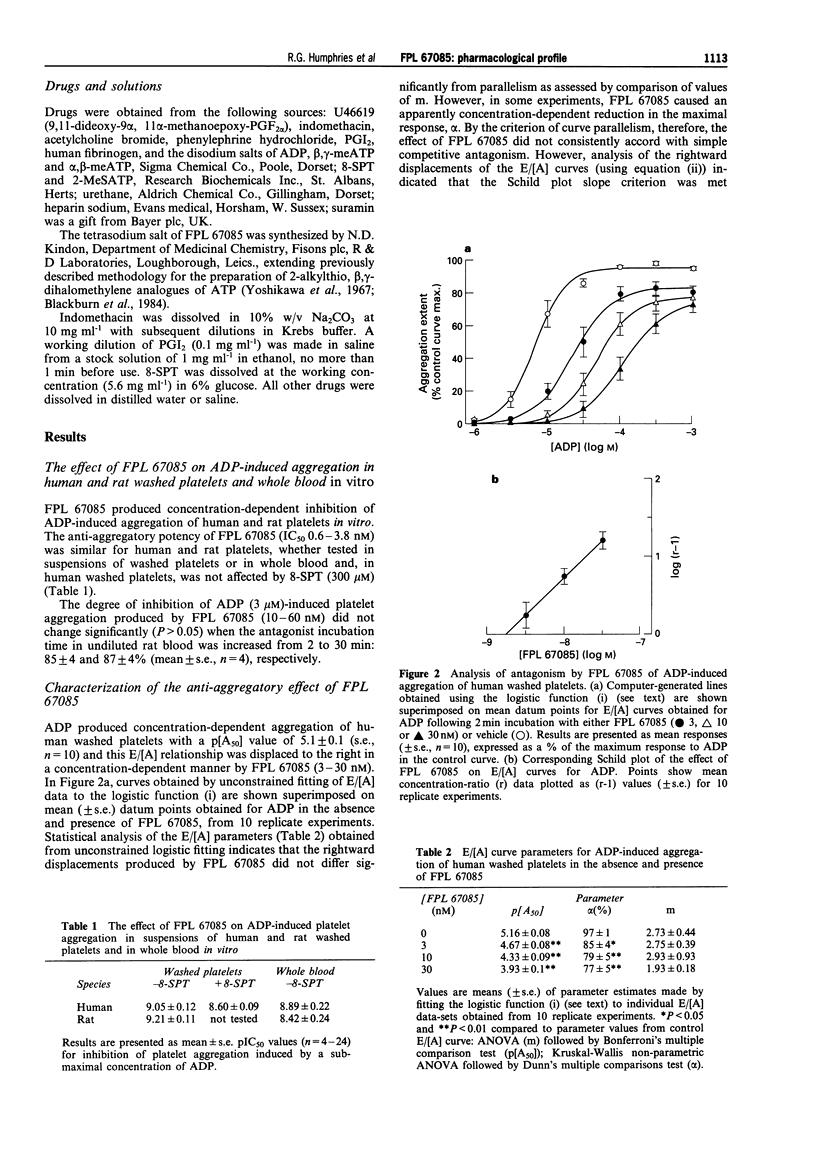
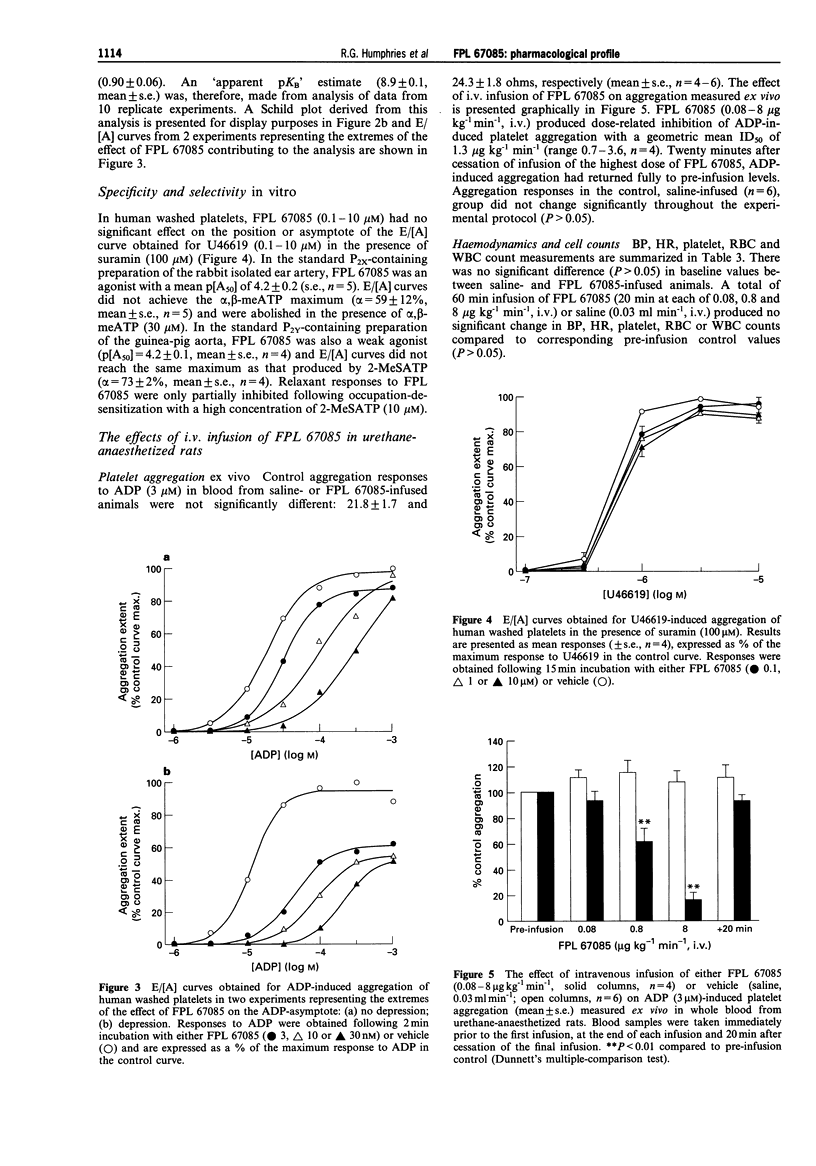
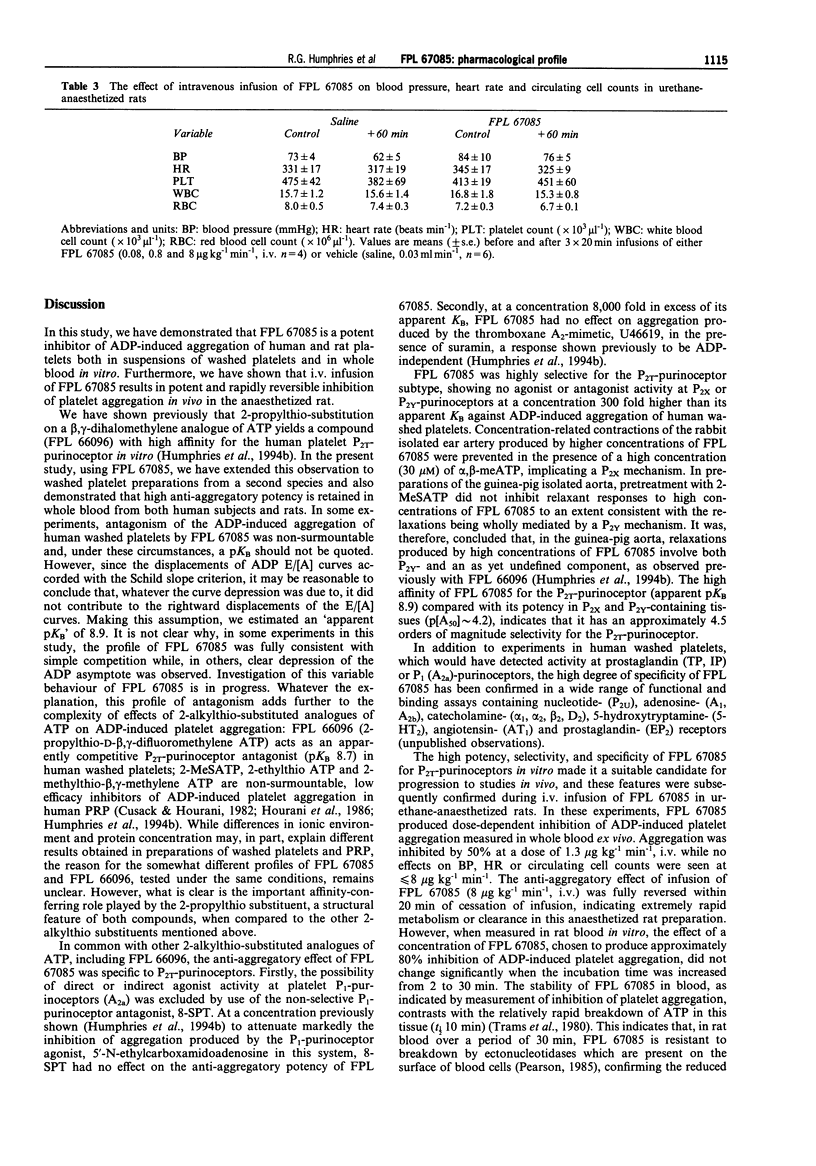
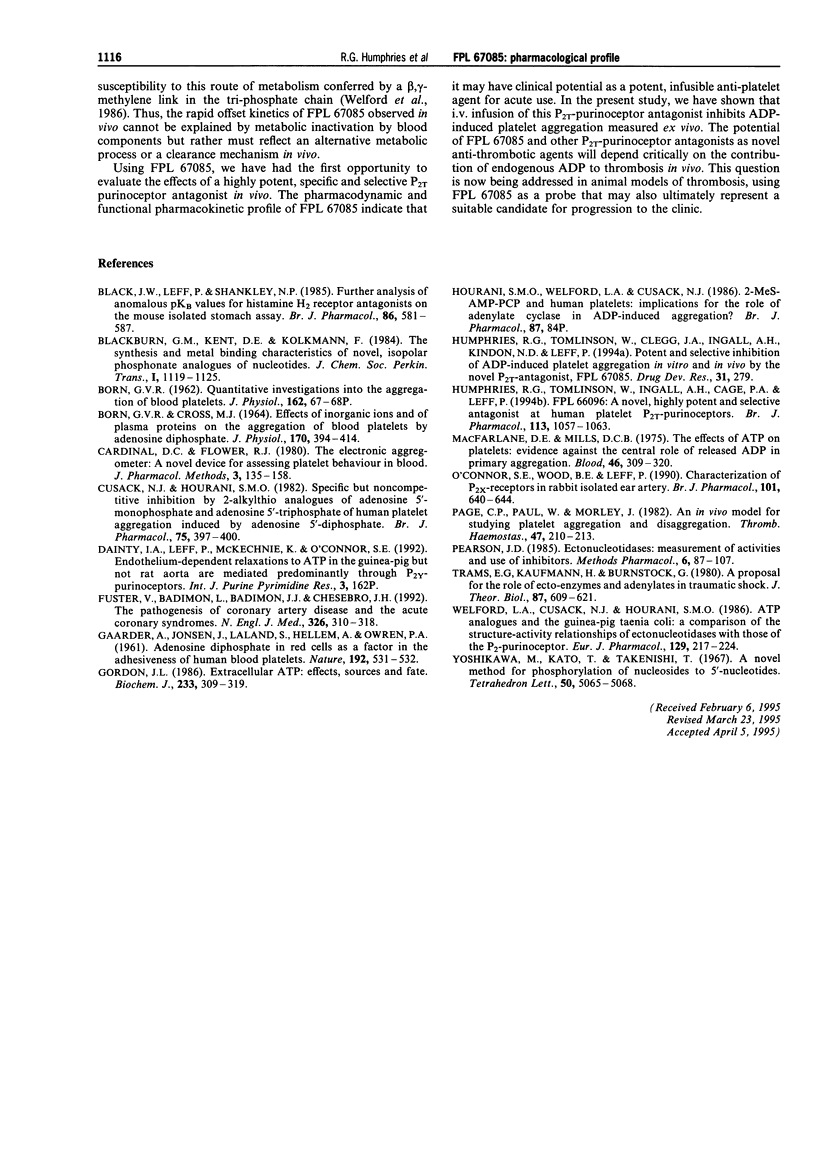
Selected References
These references are in PubMed. This may not be the complete list of references from this article.
- BORN G. V., CROSS M. J. EFFECTS OF INORGANIC IONS AND OF PLASMA PROTEINS ON THE AGGREGATION OF BLOOD PLATELETS BY ADENOSINE DIPHOSPHATE. J Physiol. 1964 Mar;170:397–414. doi: 10.1113/jphysiol.1964.sp007340. [DOI] [PMC free article] [PubMed] [Google Scholar]
- Black J. W., Leff P., Shankley N. P. Further analysis of anomalous pKB values for histamine H2-receptor antagonists on the mouse isolated stomach assay. Br J Pharmacol. 1985 Nov;86(3):581–587. doi: 10.1111/j.1476-5381.1985.tb08934.x. [DOI] [PMC free article] [PubMed] [Google Scholar]
- Cardinal D. C., Flower R. J. The electronic aggregometer: a novel device for assessing platelet behavior in blood. J Pharmacol Methods. 1980 Feb;3(2):135–158. doi: 10.1016/0160-5402(80)90024-8. [DOI] [PubMed] [Google Scholar]
- Cusack N. J., Hourani S. M. Specific but noncompetitive inhibition by 2-alkylthio analogues of adenosine 5'-monophosphate and adenosine 5'-triphosphate of human platelet aggregation induced by adenosine 5'-diphosphate. Br J Pharmacol. 1982 Feb;75(2):397–400. doi: 10.1111/j.1476-5381.1982.tb08800.x. [DOI] [PMC free article] [PubMed] [Google Scholar]
- Fuster V., Badimon L., Badimon J. J., Chesebro J. H. The pathogenesis of coronary artery disease and the acute coronary syndromes (2). N Engl J Med. 1992 Jan 30;326(5):310–318. doi: 10.1056/NEJM199201303260506. [DOI] [PubMed] [Google Scholar]
- GAARDER A., JONSEN J., LALAND S., HELLEM A., OWREN P. A. Adenosine diphosphate in red cells as a factor in the adhesiveness of human blood platelets. Nature. 1961 Nov 11;192:531–532. doi: 10.1038/192531a0. [DOI] [PubMed] [Google Scholar]
- Gordon J. L. Extracellular ATP: effects, sources and fate. Biochem J. 1986 Jan 15;233(2):309–319. doi: 10.1042/bj2330309. [DOI] [PMC free article] [PubMed] [Google Scholar]
- Humphries R. G., Tomlinson W., Ingall A. H., Cage P. A., Leff P. FPL 66096: a novel, highly potent and selective antagonist at human platelet P2T-purinoceptors. Br J Pharmacol. 1994 Nov;113(3):1057–1063. doi: 10.1111/j.1476-5381.1994.tb17100.x. [DOI] [PMC free article] [PubMed] [Google Scholar]
- Macfarlane D. E., Mills D. C. The effects of ATP on platelets: evidence against the central role of released ADP in primary aggregation. Blood. 1975 Sep;46(3):309–320. [PubMed] [Google Scholar]
- O'Connor S. E., Wood B. E., Leff P. Characterization of P2x-receptors in rabbit isolated ear artery. Br J Pharmacol. 1990 Nov;101(3):640–644. doi: 10.1111/j.1476-5381.1990.tb14133.x. [DOI] [PMC free article] [PubMed] [Google Scholar]
- Page C. P., Paul W., Morley J. An in vivo model for studying platelet aggregation and disaggregation. Thromb Haemost. 1982 Jun 28;47(3):210–213. [PubMed] [Google Scholar]
- Trams E. G. A proposal for the role of ecto-enzymes and adenylates in traumatic shock. J Theor Biol. 1980 Dec 7;87(3):609–621. doi: 10.1016/0022-5193(80)90239-8. [DOI] [PubMed] [Google Scholar]
- Welford L. A., Cusack N. J., Hourani S. M. ATP analogues and the guinea-pig taenia coli: a comparison of the structure-activity relationships of ectonucleotidases with those of the P2-purinoceptor. Eur J Pharmacol. 1986 Oct 7;129(3):217–224. doi: 10.1016/0014-2999(86)90431-0. [DOI] [PubMed] [Google Scholar]
- Yoshikawa M., Kato T., Takenishi T. A novel method for phosphorylation of nucleosides to 5'-nucleotides. Tetrahedron Lett. 1967 Dec;50:5065–5068. doi: 10.1016/s0040-4039(01)89915-9. [DOI] [PubMed] [Google Scholar]


